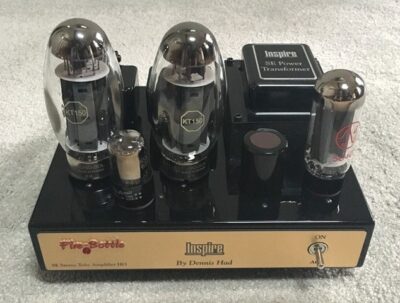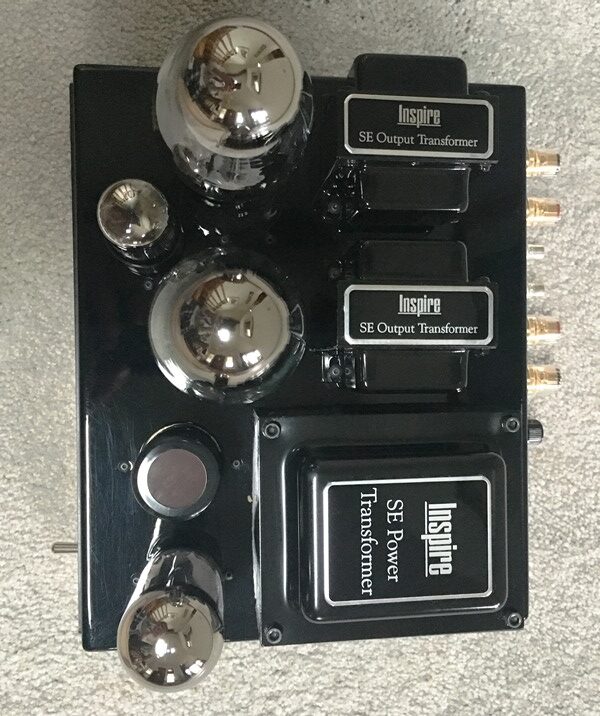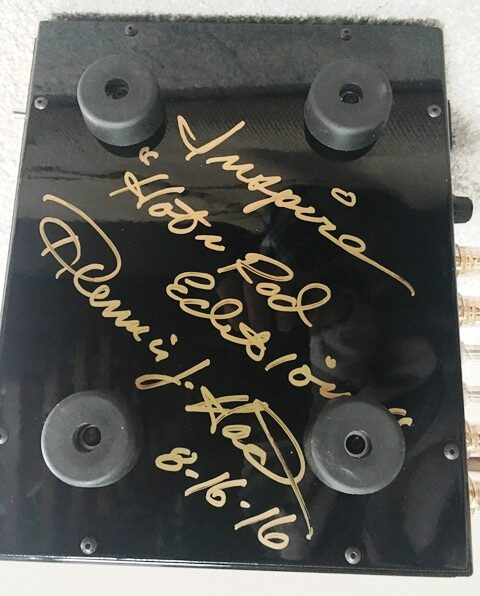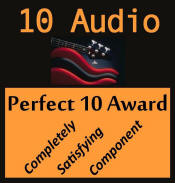It was a sad day when we heard that Dennis Had, founder and guiding light of Cary Audio, was retiring. Under his leadership, business acumen and engineering genius, Cary Audio became one of the most successful producers of audio equipment. Several Cary Audio products, both tube and solid state, have been reviewed here on 10 Audio, and this writer purchased many of the review samples.

As my decades-long audio journey has led to power amplifiers of increasing quality of sound reproduction, that journey was bound to reach the turnoff for the road to single-ended amplifier technologies. In most amplifiers, which are either tube or solid stage push-pull designs, there are one or more pairs of output devices for each channel. A driver circuit splits the phase of the incoming signal and sends the positive waveform to one of these output devices, and sends the negative waveform to the other of these output devices. While push-pull designs increase the output power over a single tube, there is always – always – the problem of what happens when the music waveform crosses from positive to negative. This crossing creates “crossover distortion” and while there have been innumerable designs to minimize it; this distortion is always present to some degree.
But not in a single-ended amplifier. One tube (or transistor) handles the entire waveform and sends it to the loudspeaker, usually through an output transformer. Crossover distortion, the bane of push-pull, is non-existent in single-ended amplifiers. You might have heard of SET, or Single Ended Triode, amplifiers. These use a triode tube for the output device. The Inspire Fire-Bottle SE stereo amplifier uses a common pentode tube, one per channel. Mr. Had supplied JJ 6V6, Genelex Gold Lion KT88, and Tung-Sol KT150 output tubes with the amplifier. A single dual-triode GE 6SN7 is used for the input tube for both channels, and a JJ 5U4GB tube is the rectifier. On hand are Tung-Sol KT120 tubes, and these were also auditioned. With outstanding results.

Here are the specs:
–Fully regulated low impedance tube screen grid B+ power supply
–Large oil filed regulated power supply section filter cap
–Filter choke Pi-Network power supply
–Precision non-inductive metal film 3 watt resistors
–Paper and oil filed, epoxy encapsulated, coupling and by-pass capacitors
–Gold plated copper output speaker posts
–EE Teflon silver stranded 19 strand hook up wiring
–Pure 99.9% Silver Teflon Insulated internal coax interconnect
–Custom design 15 watt SE air gapped output transformers with separate feed-back winding, left and right channel matched pair
–400 % duty cycle CCS power transformer designed for 120/240 VAC 50/60 Hz primary
–Separate center tapped filament transformer for the rectifier tube
–.080 (12 ga) aluminum chassis and matching bottom plate with large soft rubber shock mount feet
–12 watts per channel output with the KT-150, KT-88 or KT-120 output tubes and 5AR4 rectifier tube
–10 watts per channel output into 2 ohm loads with KT150 output tube with 5AR4/GZ34 rectifier
–Duty cycle of the amplifier is 24/7 in full operate conditions
–Harley Davidson Gloss Black powder coat finish
–Weight: 14 (fourteen) pounds
The review system includes a custom Windows 7 music computer running JRiver Media Center 22; Cary DAC-200ts and Mytek Brooklyn DACs, the latter with external power supply; Lynx Hilo AD/DA converter with external power supply; VPI Aries 3 turntable with a Kuzma 4-Point tonearm, ZYX UNIverse Premium, Miyajima Madake, Clearaudio Titanium V2, Lyra Atlas and ZYX UNIverse II moving coil cartridges; Pass Labs XP-25 phono preamplifier; Mark Levinson No. 52 and Bent Audio Tap-X and Acoustic Imagery Jay-Sho preamplifiers; Rogue Audio Stereo 100, Cary CAD-805AE, Bryston 2.5B3, Pass Labs XA30.8, McIntosh MC152, and Quad Platinum Stereo power amplifiers; and Emerald Physics 4.7, Fritzspeakers Carrera BE, augmented with a pair of JL Audio e110 subwoofers, and Focal Chorus 714 loudspeakers borrowed from the HT system. The cabling is Audioquest WEL Signature and Mogami interconnects and speaker cables. USB cables include Wyred4Sound USB PCOCC Premium and Lavricables “dual head” cable. Power protection and purification are provided by a PS Audio Dectet for the preamplifiers and source components, and a PS Audio Quintet for the power amplifiers. The latter provides remote turn-on and -off of power amplifiers that lack a 12V remote trigger.
The overall sound quality of your audio system totally depends on maintaining the quality of the signals coming out of your source component, be it a phono preamplifier, digital-to-analog converter, tape machine, tuner, or other source. If you have a great DAC or phono cartridge, it is being wasted to some degree if the preamplifier, cables, amplifier or speakers impart a limit on that greatness. When the music signal reaches the power amplifier, this is another make-or-break point in the audio chain. As we discussed above, most power amplifiers are push-pull designs where the first thing that happens to the incoming audio signal is to split it into two signals, one positive and hopefully one perfectly identical but inverted. Sure, it is possible that it could be perfectly identical but inverted, but we know the odds of that actually happening with real world hardware are not certain. If this anomaly is present, then before the amplifier has a chance to boost the signal to a level usable by your speakers, the music signal is already degraded. Not a good start. A single-ended amplifier avoids that potential harm.
Dennis had been using my amplifier in his home system for a while. When we discussed a purchase, I asked if there were any parts upgrades that he felt would be worthwhile. Here is his response:
“I am sure you have heard of the “Hot Rod” Lincoln ….. well, I call this guy the “Hot Rod” Inspire. I put in on this amp every item I felt could have a sonic impact. From the silver plated input RCA jacks to additional power supply filtering, huge silver coupling capacitors along with custom wound output transformers featuring 99.9% silver EE Teflon insulated transformer lead outs.”
These upgrades added a reasonable premium to the original cost of $1295. The unit under review is the “Hot Rod Inspire Fire-Bottle SE Stereo Power Amplifier”.

Humans have a primal, unconscious guard up against potentially harmful sounds. Just as the pupils in your eyes get smaller in bright light, your ears go on the defense when distorted or potentially damaging sounds are present. This is the ear’s equivalent to your body preparing to fight, or talking with your boss. You’re on guard. Within minutes of the music starting to play through the Inspire amplifier, I felt that tension draining away. Connected to the Emerald Physics EP4.7, with 95 dB sensitivity, a feeling of aural relaxation and acceptance filled the listening room. Some further break in was useful, 50-100 hours. Even now, the sound is very promising.
The believability of voices is at a remarkably high level. Bells and cymbals and other high frequency sounds that have complex harmonic sructures are amazingly pure and true, and the bass is articulate and resonant. The typical tube weaknesses of less absolute power and leading edge of bass sounds is still present to a degree, as is a relative reduction of upper frequency loudness. However, while bells don’t quite “tinkle” at the same relative volume level compared to lower frequency sounds as is apparent with some amps, all the detail and resolution is present, just with a more natural and realistic response. Cymbals, for example, stay back with the drums and do not appear to be positioned next to the lead singer as with many other amps. The fade of ringing bells, being so pure and resolved, lasts a very long time. Nothing is missing. The rich, very dense midrange and treble balance is correct. This harmonic density energizes the air in the listening room, delivering a compelling listening experience.
Single ended amplifiers, and often the top echelon of traditional amplifier technologies, are known for the purity of their sound. The Inspire Fire-Bottle amplifier delivers such a pure and open and correct musical performance that I was literally stunned at how present and lifelike people sound. Voices have an unexpected, tactile presence. You gotta hear this! Whether from another Inspire SE amp, or another single ended tube amp, really, you must hear this type of amplifier in your own system! The sound is so enjoyable that you might aquire appropriate speakers to keep this amplifier in your system. This is contrary to common wisdom, which is first to chose your loudspeakers and then get an amp to drive them. In the case of the Inspire amp, a reasonable approach is to place the primacy with the Inspire, first and formost. Then pick a good match in the speakers.
I found the 6V6 tubes to have a nice warm midrange, but with noticeably limited bass and upper treble response. KT88s sound very good, although I preferred the upper frequency clarity and extension offered by both the KT120 and KT150 tubes. The KT120 power tubes sound wonderful with the 95 dB Emerald Physics 4.7 speakers, which can deliver 90 dB SPL at the listening seats in my room with only 1.5 Watts (and 100 dB SPL with 15 Watts). These power tubes were also preferred with the Fritzspeakers Carrera BEs which have much lower efficiency spec of 87 dB. To get the same speaker output as 1.5 Watts driving the EP4.7s, you would need to give the Carreras about 9.5 Watts.
In the (maybe too late) attempt to protect my hearing, I usually listen at less than 85 dB peak SPLs. Where the Inspire amp easily drove the Emerald Physics speakers to these levels, there was a small sense of strain with the Carrera BEs which is understandable when we see that the recommended power for these speakers is 50-200 Watts RMS (not peak). The Inspire amp seems laughably underpowered for these speakers. And yet, at SPLs around 80 dB, which is usually very satisfying, the pairing is magical.

To address this occasional sense of strain, a pair of $11,995 Cary CAD-805AEs appeared in my listening room. These 80 pounds (each) mono amplifiers offer about 50 Watts of beautiful single-ended triode power. Dennis Had designed this amplifier, too. The Cary SET amp is “big iron”. Just one of its two output transformers weighs more than the entire Inspire amp. The sense of strain at higher volume level was instantly dispatched upon the installation of the 805AE amps. Bass firmed up and became more powerful, too. In all other areas, these two amplifiers sound remarkably alike, and their differences can change with a change in tubes: the options mentioned above for the Inspire amp, and changing the 805AE power tubes to either 845s or 211s. Which amplifier seems to have an advantage depends to a large extent on which tubes are installed, and what speakers are in use. For example, I preferred the Inspire amp with KT120s and the Cary amp with 211 tubes. The audible differences between the KT120s and KT150s tubes in the Inspire amp are similar to the differences between the 211 and 845 tubes, respectively, in the Cary amp. Powering the Carrera BE speakers, the Inspire amp with KT120 tubes sounds more believable than the Cary amp sounds with 845 tubes, the absolute maximum loudness not withstanding.
And then there is the issue of heat, which is relevant as we approach the warmer months. The Inspire amp emits less heat than the Rogue Stereo 100 with its four KT120 tubes, and FAR less heat than the Cary 805AE. The mono 805AEs run hot, everywhere, tubes, transformers, chassis, even the power switches get warm. We’ll see what happens when the summer months arrive, but I expect that the Inspire amp will be put back into service and the 805AEs turned off. The Bryston amp runs the coolest of all the amps used during the audition period. The Carrera BEs have replaced the EP4.7 as my reference speakers and are used with a pair of JL Audio e110 subwoofers to fill in only the lowest 10 Hz of bass. The JL Audio subs are connected from their high level inputs to the Inspire’s speaker terminals. This enables a seamless blend as the character of the bass is consistent from the Carrera’s woofer to the subwoofers. They both get their inputs from the Inspire’s outputs.
All of the bass is present with the Inspire amplifier; it just might not have the current delivery to drive a woofer to expected levels. The bass is deep, controlled, and very satisfactory, although not up to the solid state standard set by the McIntosh or Bryston amps in leading edge impact. However, the tube amps win with what comes after the initial impact.
The Hot Rod Inspire Fire-Bottle SE Stereo Amplifier is easily one of the best sounding power amplifiers available today, consistently delivering sonic performances that are completely involving and enjoyable. Depending on your speakers, room size and desired listening level, it could easily be all the amplifier you need. I have a tendency to not keep an inventory of components on hand, mainly due to a lack of space for storage. In the case of the Inspire amp, it is so small and light weight, low cost, and having superb sonics that it is a keeper, even if it might only be used when more efficient speakers are visiting, or during the warmer summer months. In those cases, the Inspire amp will be my first choice to obtain the best possible sound.
Overall Rating: 10 LPs

Link to manufacturer: check eBay for radioman731. Supply is very limited.
